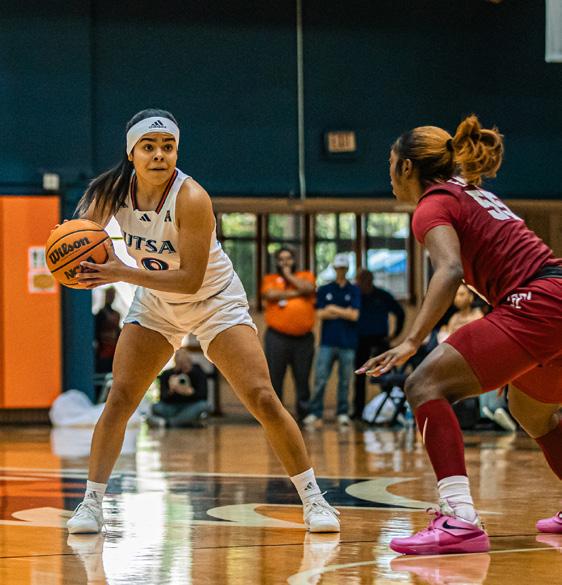THE PAISANO









By Khoi Nguyen Staff Writer
Local philanthropist Harvey E. Najim has donated $1.25M to the San Antonio Food Bank to feed UTSA students. Representatives from UTSA and the San Antonio Food Bank celebrated in the Main Campus Student Union on Jan. 29, announcing the donation will be divided over the next 10 years, with $125,000 going to the food bank each year. Amidst rising food prices, it comes as part of a larger mission to fight food insecurity at UTSA and in San Antonio.
The SA Food Bank distributes millions of pounds of food to over 500 organizations across Southwest Texas, including UTSA. Najim’s donations will help supply the Roadrunner Pantry, an on-campus resource providing students with free food, at both UTSA’s Main and Downtown Campuses. Najim has also announced monthly food drives in conjunction with his donation.
“Students will no longer have to choose between tuition, books, gasoline for the car and food. I don’t want them to make that choice,” Najim said.
Najim’s relationship with UTSA has been marked with significant financial contributions. His previous donations to UTSA include $3 million to establish UTSA’s Career Advancement Center, $2 million to expand it to UTSA’s Downtown Campus and $2 million committed to
the Roadrunners’ Football program. His donation to the San Antonio Food Bank is the latest installment among these contributions.
“It’s tough to feel secure when your stomach is growling and you’re hungry,”
Eric Cooper, president and CEO of the San Antonio Food Bank, said. “So the opportunity to really nourish students, make sure they have access and a resource to get nourishment here on campus is pretty incredible.”
In a 2024 study from the Government Accountability Office, nearly a quarter of college students experienced food insecurity in 2020. The study found that among food-insecure students eligible for SNAP benefits, 59% did not take advantage of them. Rising food prices pose another obstacle in access to food. According to Nerdwallet’s review of the Consumer Price Index, food prices have risen 28% since 2019.
Part of the Roadrunner Pantry’s mission is ensuring that students are aware of the resources they can access — the pantry being one of them.
“Getting the word out there about the pantry is the best way to help us fight food insecurity,” Esperanza Regalado, a student assistant for the pantry, said.
Since its opening in 2017, the pantry
By Izabella Hernandez Staff Writer
President Donald Trump’s administration rescinded restrictions that prevented Immigration and Customs Enforcement on Jan. 20 from entering and conducting raids on schools, churches, hospitals and other public service facilities. In efforts to carry out his deportation agenda, Trump has instructed ICE to cement a quota of 1,200 to 1,500 arrests per day.
UTSA’s Office of Legal Affairs sent out a mass email on Feb. 4 updating students and faculty on the institution’s policies regarding increasing immigration enforcement in schools nationwide.
“With guidance from the UT System, we have an update and resources to share regarding the U.S. Immigration and Customs Enforcement and our institution. As a Texas educational institution, UTSA must follow all applicable and federal laws and UT System policies regarding cooperation with federal authorities,” the email states. “We will carefully review any request from authorities on a case-by-case basis and will consult with the UT System as needed.”
Following the protest at City Hall on Feb. 5 when San Antonio Independent School District students walked out of class in protest of ICE raids in schools, the grassroots coalition Right to Rebel organized a protest on Feb. 6. UTSA students gathered under the Sombrilla to protest UTSA’s cooperation with ICE as a part of Trump’s executive order to carry out mass deportations nationwide.
A student at UTSA, who has decided to remain anonymous, heard about the protest through social media and shared their thoughts on why it was important to attend.
“I think it’s important to speak for the people that can’t be here,” the student said.
“I think it’s honestly really just outrageous that we are punishing the people that keep the economy growing and the people that just want a better life. That should be something to admire, not something that should be pushed down.”

The email also provides additional resources provided by the Office of Legal Affairs containing information about steps to take in a potential interaction with external law enforcement officers, including federal immigration officers, on university property.
now averages 200 visitors per day — offering goods, like peanut butter, bananas, water and toilet paper for free.
While the number of visitors has grown, the pantry encourages more students to make use of its provisions.
“A lot here goes to waste, so might as well have people take advantage of it,” Sebastian Legorreta, another student assistant, said.
Cooper points out that stigma may deter students from using the pantry.
“People feel like they’re failing or have done something wrong,” Cooper said. “There’s no shame. If you need help, the food pantry is going to be there to help.”
Though many of its resources are supplied by the San Antonio Food Bank, the Roadrunner Pantry also relies on community support to maintain its services.
Students volunteer — stocking and cleaning up the pantry — or donate. Last fall, the pantry raised over $22,000 in a friendly competition with Texas State’s pantry. Additionally, the
Feeding Futures Society, a newly formed student organization, seeks to drive community effort against food insecurity by supporting the pantry and organizing volunteer opportunities.
“We rely a lot on our community,” Regalado, who is also an officer of the society, said. “Having these helping hands helps us accomplish our mission even more.”
The Roadrunner Pantry can be accessed at 1.04.06 in the Student Union for the Main Campus and at 1.306 in the Durango Building for the Downtown Campus. To volunteer at the pantry, students can sign up on RowdyLink or email RoadrunnerPantry@utsa.edu for more information. The San Antonio Food Bank can be found at 5200 Historic, Old Hwy 90. More information can

By Marisela Cruz Assistant News Editor
On the steps of City Hall, a student spoke in front of their peers and said, “I dream of a day where there is not any violence and there isn’t any hate.” The steps below were filled with students, teachers and other protesters speaking out about their fear and frustration amid all the new executive orders President Donald Trump has issued.
Chants and cries regarding change and safety for all filled the street of 100 Military Plaza. Students projected their voices to keep children safe, protect human rights and keep immigration enforcement out of schools.
One student in particular said that he is tired of how “the bureaucratic system control[ing] us. We have a right to be able to have abortions. We have a right to choose where we live, and we have a right to vote!” A teacher reassured the unified group of students among their classmates with a message stating, “You are the next generation that’s going to make a difference.”
San Antonio Independent School District students and grassroots coalition Mujeres Marcharan organized the walkout to protest against recent executive orders: the federal funding freeze, the end of birthright citizenship and the banning of all gender-affirming care for people under 19 years old. Pride flags, Mexican flags and
protest messages on various banners and boards crowded City Hall on Feb. 5. “No to deportations — Keep families together” and “Money for hormones not war” were among the messages San Antonio students carried with them.
On Jan. 20, Trump issued many of the executive orders that San Antonio students are protesting. SAISD Superintendent Jaime Aquino said, “There was a spike in absences the day after parents learned of the news.”
City Councilman Jalen McKeeRodriguez attended the protest to show support for San Antonio students. McKeeRodriguez, who is Black and openly gay, shared his fears for his safety alongside the students’ concerns.
“My heart hurts that they’ve lost a lot of the innocence that they’re owed, and they have to be out here worried and advocating for themselves and for their futures,” McKee-Rodriguez said.
As a former high school math teacher, McKee-Rodriguez found inspiration within students’ passion for change when running for office. McKee-Rodriguez also emphasized that he hopes that the students of San Antonio know “that there’s people who are here for them, and this generation is not left on their own.”
Another protest was held in Pica Pica Plaza this past Saturday as a continuation of the protest to stop the Trump administration’s anti-immigration policies.
By Luna Infante Assistant Magazine Editor
UTSA recently launched SafeZone, a free mobile app that was announced on Jan. 29 by the school’s public safety department through the business affairs’ YouTube channel. In the video, UTSA’s Chief of Police Stephanie Schoenborn encourages the community to download the app, emphasizing how accessible emergency services are with “Fast and easy access to UTSAPD.”
The UTSA public safety website states, “SafeZone helps you stay connected and safe at UTSA by offering on-demand access to emergency services and UTSAPD at the touch of a button.”
One of the app’s features is an emergency button that either connects users to UTSAPD or calls 911. The app also includes non-emergency communication, a confidential mental health crisis line, emergency alerts, UTSAPD report-making and location privacy.
can file anonymously with the option to share the location of the incident and attach photos to the report. The privacy feature turns locationsharing on and off.

When making police reports on the app, users
“The free safety app offers instant access to emergency dispatchers and responders, accurately pinpointing and sharing your location when help is needed. Your device’s GPS is only activated when you initiate an alert, and location sharing automatically ends once the alert is canceled, ensuring privacy,” stated the UTSA Public Safety website. the event of an emergency or non-emergency incident on campus, app users can quickly raise an alert to UTSAPD,” UTSA Today shared.
“Once an alert has been raised, the device’s location is shared with UTSAPD, and the app can be used to call UTSAPD or communicate with them via two-way messaging.”
SafeZone can be downloaded from the App Store and Google Play. UTSA’s former safety app, LiveSafe, is no longer available.
By Alejandra Garza Staff Writer
Governor Greg Abbott recognized the importance of teacher pay in Texas and how it directly affects students’ success. This issue was communicated in Abbott’s State of the State address announcing it as an emergency item to the Texas Legislature.
“An essential element to better education for our kids is having the best teachers,” Abbott said. “One thing we must do this session to attract and to keep the best teachers is to increase their pay.”

“We want to make sure that our teachers are on a pathway to earning a six-figure salary in some opportunities but also that we increase the average teacher salary to an all-time record in the state of Texas,” Abbott added. “That’s why I am making increasing teacher pay an emergency item this session.”
In a comprehensive release, the Abbott administration recorded the efforts already made by the Texas government.
“Texas Incentive Allotment program in 2019 provided over $575 million in merit-based pay raises to more than 25,000 teachers through the program and invested over $500 million to enhance the state’s public school curriculum to give teachers more time to focus on instruction, support students and reduce lesson planning burdens,” the release states.
The release also provided a framework of how the Texas governor will increase teachers. Some of the ways that the Texas Legislature hopes to improve teachers’ salaries include “[waiving] of fees for certification in high-need areas like special education and bilingual education” and “[investing] in high-quality teacher preparation pathways, including teacher residencies, apprenticeships and grow your own programs.”
Multiple school districts have come forward with statements regarding the Governor’s recent announcement.
North East ISD:
“We are in favor of a teacher pay increase, and we are also in favor of support staff getting
an increase too. There are many people in a school district that are instrumental to a child’s education, including custodians, school nutrition staff and bus drivers, just to name a few” Northside ISD:
“We welcome an increase in teacher salaries and an elevation of the teaching profession. Teachers take on one of the most important responsibilities in our society: educating our next generation. Paying teachers a professional salary aligned with their critical role is the right thing to do and is also necessary to improve student performance and our economic future.”
Schertz-Cibolo-Universal City ISD:
“In SCUC, we believe competitive pay is essential to attracting and retaining the highquality teachers who are and will shape the future of our students. We remain committed to advocating for pay that reflects their dedication. Our teachers, just like school districts and families around the state, are dealing with the effects of double-digit inflation that continue to eat away at their hard-earned paycheck. Therefore, we appreciate the Governor’s focus on increasing teacher compensation and expanding programs that support educators. We look forward to seeing how the elements of this “emergency item” develop during the legislative session. We will continue communicating with our state leaders to ensure these investments directly benefit our educators who are making a difference daily in the lives and futures of our students.”
Teacher pay was only one of many topics discussed in Abbott’s address. This is still a developing story.
By Johnpaul Buwule Contributor
In compliance with the Clery Act, UTSA keeps a daily crime log for all on-campus crimes. The log summarizes the case’s date, time, location, incident and current status. The crimes detailed below are taken directly from the crime log, showcasing the trends premiered from Feb. 2 to Feb 8.
The UTSA Police Department reported an individual evading arrest on Feb. 2. Still active, the case occurred at the Bus Stop Oval, with the interaction beginning at 6:45 p.m. and ending at 7:36 p.m.
Larceny/theft
The event occurred from 4:15 a.m. through 3 p.m. on Feb 2. to Feb. 3. UTSAPD received a notification about larceny at Laurel Village, which amounted to $750 to $2,500. It remains an active case.
Graffiti
A resident at Laurel Village reported a stalking incident on Feb. 3. The case, which happened from 9:21 p.m. to 10:15 p.m., is still active.
Duty on striking an unattended vehicle
On Jan. 30, two offenses of duty on striking an unattended vehicle were reported to UTSAPD. The first incident occurred at Resident Lot 5 while the second occurred at East Campus Lots. Both cases remain active.
Driving under the influence of alcohol by a minor
On Jan. 31, between 1:33 a.m. and 2:03 a.m. at Brackenridge Ave. Lot 2, a driving while under the influence of alcohol by a minor offense occurred. The incident was cleared by arrest.

San Antonio Immigration center closed
By Anika Engler Staff Writer
San Antonio halted operations at the Migrant Resource Center, on Monday, Feb. 3 due to the significant decline in migrants arriving. The MRC was established in July 2022 to assist migrants traveling through San Antonio.
The center offered services such as case management, local transportation, navigation assistance, food and access to communication devices. San Antonio has helped over 640,000 migrants transit through the city to reach their final destinations safely. However, the drastic 72% decrease in the number of migrants traveling through the city from January 2024 to January 2025 is prominent. Last January, the MRC served 8,264.
District 10 City Council Marc Whyte showed his support for the decision. “As the City now finds itself in a place where future funding for the MRC is in doubt, closing the MRC was the only option as we should never consider using our residents’ tax dollars to fund such an operation,” Whyte explained. “Our city dollars should be strictly focused on delivering high-quality services to our residents, including enhancing the safety and preserving the character of our city.”
Mayor Ron Nirenberg informed the public, “San Antonio remains a compassionate community which will continue to work with our partner agencies to meet any additional migrant arrivals with care.”
This January the center served 2,316 migrants. According to various city estimates, running the facility came out to a monthly cost of between $800,000 and $1.2 million. The lease would last them until 2032. A city spokesman claims that the city spent a monthly amount of $500,000 on the facility. The city calculates that approximately $12.4 million is still waiting for compensation from the federal government, as of this month. Local officials gave statements concerning the immediate shutdown. “The number of migrants currently arriving at the MRC no longer justifies the cost of running it,” City Manager Erik Walsh said. “I think we’ve seen about an average of 12 for the last week per day.”
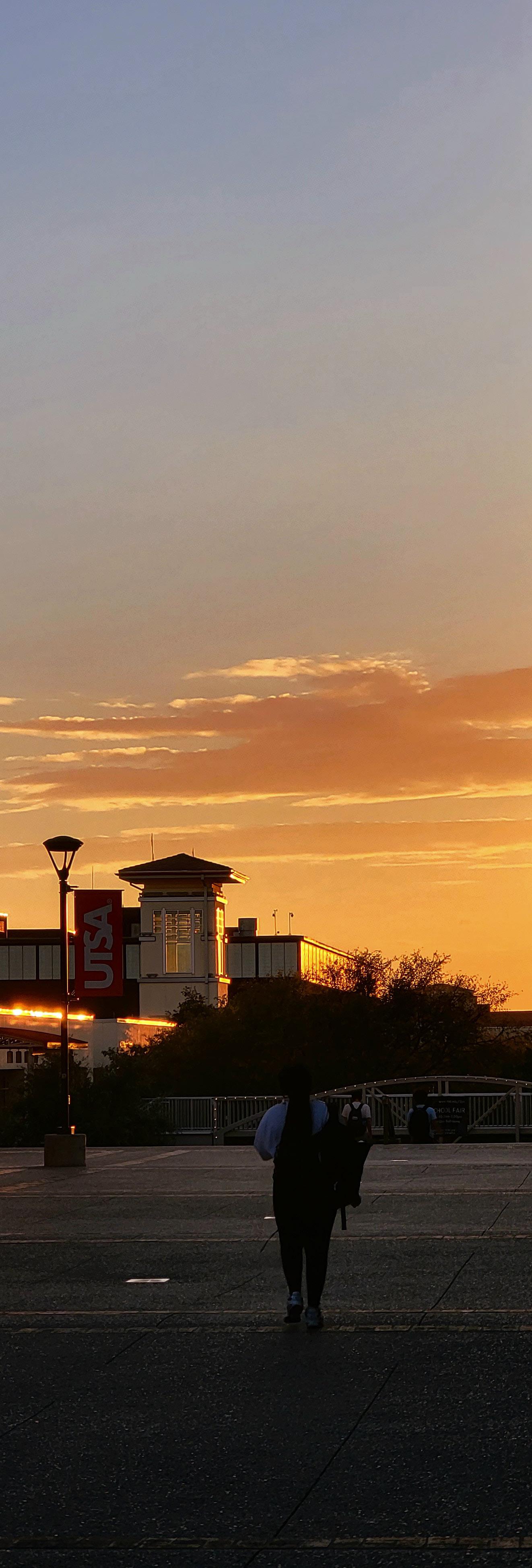
By Victoria Rodela Contributor
Not subscribed to local news but still want to stay up-todate on the happenings around town? Look no further. Highlighting notable stories from external San Antonio news sources, State of the City summarizes the most captivating news headlines of the week. This week’s topic ranges from a fatal police chase to the closing of the city’s migration center.
Police chase ends in one death and one in critical condition
Many witnesses recall a police chase on Thursday, Feb 6. in downtown San Antonio near North Flores Street and Commerce Street. The incident started as a routine traffic stop that escalated when police discovered a stolen vehicle after running the plate. Officers boxed the suspects in using spikes, but the driver refused to stop. The stolen car backed up, striking patrol cars as well as another vehicle. Officers who had exited their vehicles in an attempt to apprehend the drivers, were driven at. In response, the officers started shooting the vehicle. After the shooting, the car drove one block before crashing into a building and catching on fire. The driver was declared deceased on the site, while the passenger was transported to the hospital in critical condition.
Starting in Travis Park and moving to Texas Senator John Cornyn’s Office on Navarro St, Bexar County Democrats organized a protest on Feb. 6 to oppose Elon Musk’s recent involvement in government. The protests were said to hold Senator Cornyn accountable for failing to protect U.S. institutions from corporate overreach, as it was his constitutional duty.
“Elon Musk has no business in the treasury payment system,” organizer Michelle Solis said. “He has no business sending emails threatening every federal worker, has no business doing Medicare, Medicaid, closing down USAID, you name it.”
Just after his inauguration, President Donald Trump signed an executive order to create the Department of Government Efficiency and placed Elon Musk in charge. The protesters came close to Senator Cornyn’s office, but staff told them no one was there. Cornyn hasn’t made a statement about the protest on Feb. 6. However, in response to similar protests in the past, Cornyn voiced his support for the decisions of Trump and Musk.
Steven Robert Sablan was sentenced to 35 years in federal prison for kidnapping a 13-year-old girl at gunpoint in San Antonio in July 2023. The court came to its decision on Sunday, Feb. 9th after Sablan admitted to driving the victim to California where he threatened her with a gun and sexually assaulted her multiple times throughout the ride. The girl was rescued in Long Beach, California on July 9, 2023 when a passerby noticed her holding up a sign that read “Help Me” in the window of Sablan’s Nissan Sentra. Along with 35 years in federal prison, United States District Judge Fernando L. Aenlle-Rocha ordered Sablan to pay $1,158 in restitution.
The U.S. Agency of International Development was founded in 1961 by President John F. Kennedy, as an independent federal government agency tasked with providing civilian foreign aid and development assistance. USAID came under fire at the beginning of President Donald Trump’s second executive term as part of his reworking of the country’s foreign policy. Trump’s move to dismantle USAID is both irresponsible and illegal. His decision casts aside American citizens and millions of people worldwide who depend on USAID programs.
On Jan. 20, Trump signed an executive order freezing almost all U.S. foreign aid initiatives for 90 days, which impacted a large portion of USAID’s programs worldwide. On Feb. 4, Trump signed another EO announcing a review of the U.S.’s participation in and funding of international organizations such as UNESCO. In line with that, starting on Jan. 27, the Trump administration put over 600 USAID officials and personnel at home and abroad on administrative leave.
On Feb. 7, federal judge Carl Nichols of the U.S. District Court for the District of Columbia blocked the attempt by issuing a temporary restraining order that reinstated the staffers and allowed those stuck on foreign soil 30 days to return to the U.S. at the government’s expense. Despite
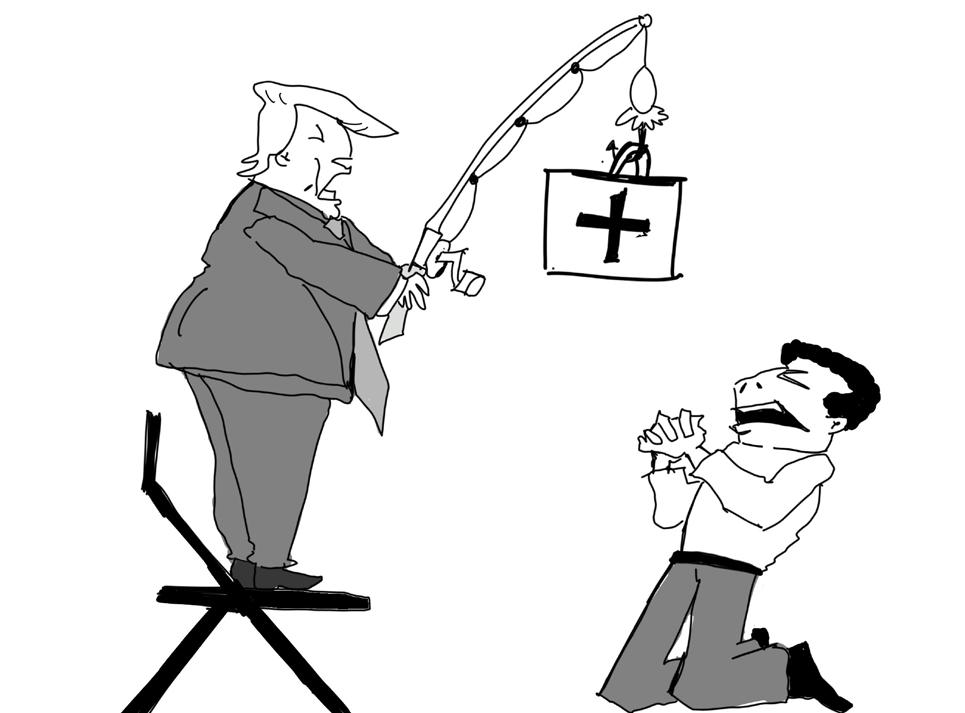
the block, USAID personnel were turned away from their offices in Washington when they showed up to work on Monday and tarps were hung over the agency’s interior signage. Further, the agency’s website and X account have been suspended and are no longer accessible to the public.
The involvement of Elon Musk and his Department of Government Efficiency is questionable, as their investigation into USAID recommended its dissolution. According to ProPublica, the way DOGE’s investigation into USAID’s financial records was carried out might have broken federal law. “USAID is a criminal organization,”
Commentary
By Sofia Mejia Magazine Editor
Class rings, a once-honored tradition, are now a costly mistake. The rings have lost their charm. With a price tag of half a grand, colleges should not be surprised when they lose favor with students.
Originally a tradition started in 1835 at the U.S. military, these rings served as a conversation starter and led to important connections with people outside of college campuses due to a shared sense of comradery.
In the 190 years since, a lot has changed, particularly higher attendance in college. In the 19th century, there were a little over 800 universities in the U.S. Now, there are over 6,000.
One thing that has changed is the elitism. The former exclusionary nature of college made class rings an effective display
of status, but with more people having college access, it has simply become a fashion choice.
For those looking to have a memento of college, there are far more meaningful and less costly choices. UTSA rings start at $533. While the university justifies this cost with, “No other single item replicates the uniqueness of UTSA,” one look at the ring tells a different story. There are only so many ways to make a ring — small as it is — different from other rings.
College is already a huge expense for students, who typically work low-paying jobs. In a time when everything is more expensive, the idea that students should feel obligated to buy a ring to be connected with the school is outrageous. The expensive degree they pay for should be enough to feel connected with the school. Mementos bring more joy than a ring bought through a form with a deadline.
Commentary
By Jasmine Williams Managing Editor
Just as Smokey the Bear told Americans in the 1940s “Only you can stop a forest fire,” someone needs to tell Americans today “Only you can pay for tariffs.”
American consumers and businesses purchase imported products. As a result, they will be the ones to pay the unfathomable tariffs President Donald Trump is threatening the world with — like the proposed 10% tariff on all imports and 25% tariff on Canada and Mexico.
Unlike what Trump is claiming, tariffs will not bring economic prosperity; they will create trade barriers, increase the taxes U.S. citizens pay annually and dramatically increase inflation. This is the perfect recipe for widespread economic chaos, and Trump knows it.
Tariffs create trade barriers since they discourage international trade by hiking up the prices of foreign goods. They also trigger retaliatory tariffs, which decrease the competitiveness of domestic goods in foreign markets. Global trade has enabled many countries to specialize in specific sectors and thrive economically. A country imposing such substantial tariffs is shooting itself in the foot and setting itself back by decades.
sweeping tariffs, American households may end up paying at least $1,200 more annually in taxes. But Trump does not care about low-income Americans, as seen in his Tax Cuts and Jobs Act from 2017. It resulted in a tax cut of over $48,000 for households in the top 1% and a whopping $600 for those in the bottom 60%, the ones who would suffer the most under the tariffs.

Tariffs are inherently regressive, meaning low-income households end up paying a higher percentage of their income than high-income people. Should Trump go through with his threats of
Typically, a tariff or two is not enough to have a meaningful impact on inflation since it is too focused on one product or industry. However, Trump’s tariffs would affect every single industry from how all-encompassing and steep he says they will be. Everything from agricultural products to raw materials — like lumber, minerals, metals and gasoline — are expected to increase in price for American consumers.
The tariffs could bring great disruption to the supply chain and inhibit the Federal Reserve’s ability to stabilize prices and control inflation. is holding the American economy hostage, and he is using it as a bargaining chip to get what he wants from other countries. Had he gone through with the 25% tariffs on imports from Canada and Mexico, Trump could have sent their economies into a recession and wreaked havoc on ours. For now, the tariffs on Canada and Mexico have been pushed back until March 1, but only because the nations folded to Trump’s demands. He is well aware of what he is doing, and he knows no one out there has the audacity to stop him.
Musk published on his X account. “Time for it to die.” With it, life-saving humanitarian missions will die. Health programs around the world have shut down due to Trump’s freeze. Medicine and medical supply shipments to communities in need have ceased, and aid agencies have had to lay off staff. USAID is the world’s largest supplier of humanitarian aid and has made itself a necessity for the well-being of millions since its inception. For the U.S. to “feed [it] to the woodchipper,” as Musk put it, is to turn its back on the nation’s responsibilities and obligations as an international superpower. Furthermore, the simple truth is Trump does not have the authority to do away with USAID as he pleases. It is an independent agency that requires an act of Congress to be dissolved. His actions against the agency lacked congressional notice or approval. Thus, they violated the principles of separation of powers outlined in the Constitution and the Administrative Procedure Act. Trump’s hurry to overturn the government to suit his politics by signing EOs left and right leaves the country’s policies in disarray and the courts backed up with lawsuits. Meanwhile, the humanitarian agencies of the world will have to learn to make do without the U.S.’ key contributions while USAID personnel battle with the government to retain their jobs.
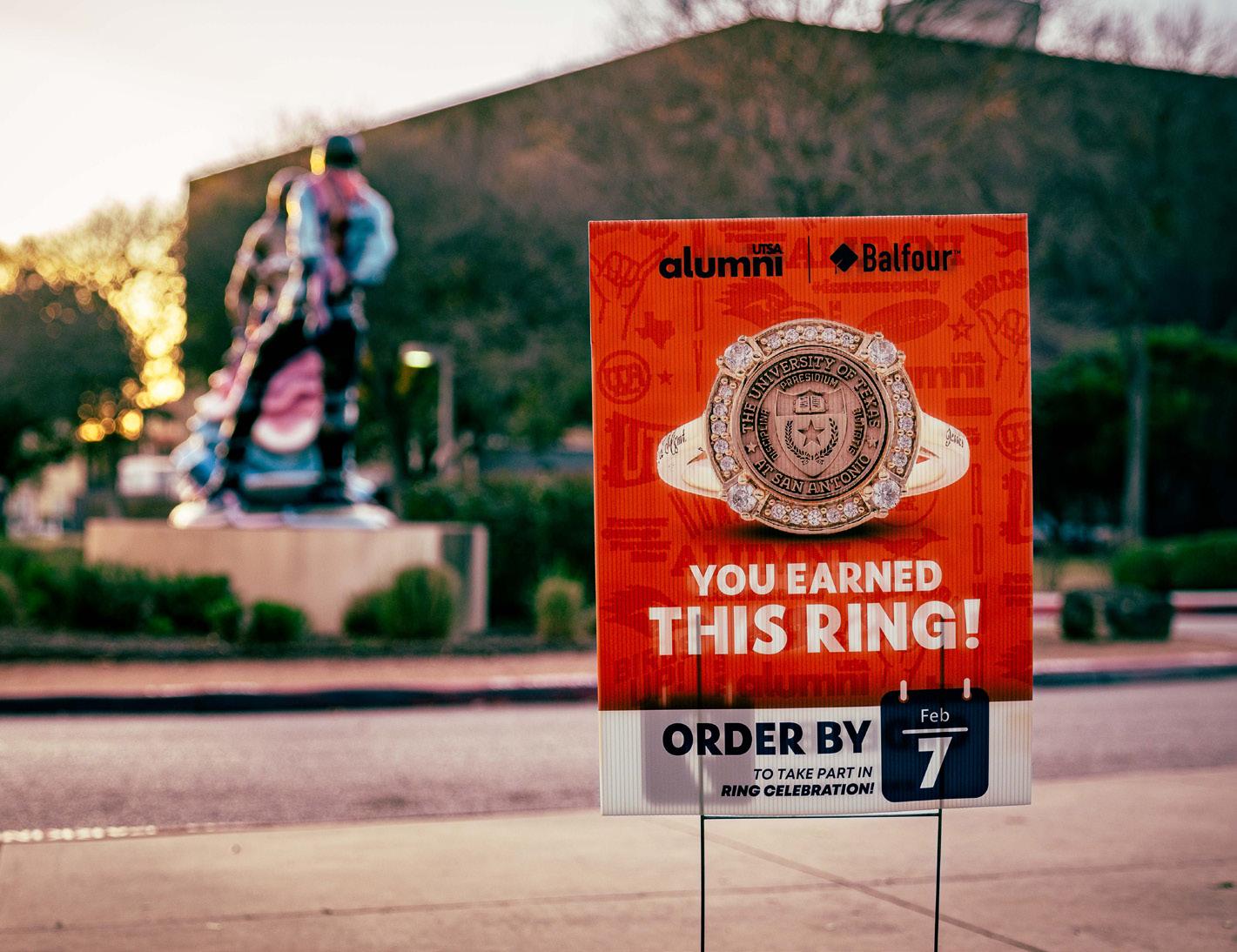
Commentary
By Selaise Gifa-Johnson Contributor
While the American education system is far from perfect, its most valuable aspects are sponsored by the U.S. Department of Education. Some of these programs provide support for children with disabilities. The children would otherwise have difficulties receiving the help they need. Other programs provide free and subsidized school lunches for low-income communities. Additionally, having the DOE promotes national unity and a common culture rooted in similar beliefs.
One of the biggest concerns with President Donald Trump’s plan to dismantle the DOE is the fact that curriculums will be controlled by individual states. State-controlled curriculums are problematic because the political biases of the individual states heavily influence how and which topics are taught, especially concerning history.
Trump has not been quiet about his beliefs that the history currently being taught in schools regarding the U.S.’s racist past consists of “lies” and “leftwing indoctrination.” These words coming from Trump are enough to significantly divide the country between those who agree with his stance and those who support comprehensive history being taught in schools.
This divide will be exacerbated if each state can influence school curriculums with their biased beliefs about historical events. The already heavily polarized country will have more disagreements about the nature of historical events, which are supposed to be factual and unrelated to the beliefs of lawmakers. If given enough
time to fester, this polarization will lead to a dangerous lack of understanding between different demographics of the population. This divide can be used by rich and powerful individuals to take advantage of the country for their own gain.
A common counterargument to parents who dislike school curriculums or potential changes to them is that they should homeschool their children or send them to a private school with a curriculum they agree with. In a perfect world, this is a good solution; however, most families with children in the public school system have their children in public school due to the unaffordability of private schools and homeschooling. Private schools are very expensive while homeschooling requires one parent not working in order to provide their child with an education, Both of these options are inaccessible for low-income families.
Given these facts, it is clear that changes to the public school system will disproportionately affect families with limited options. This is why the DOE has taken deliberate steps to bridge the opportunity gap by providing free and subsidized lunches for students in need, protecting against discrimination in public schools and providing additional funding to schools with high concentrations of low-income families. These measures, and others like additional aid for students with disabilities, are part of Title I funding provided by the DOE. If Trump is allowed to get what he wants, it will not be the families with financial security and the ability to choose how they want to educate their children that will be affected. Instead, it will be the students with no other options that suffer the consequences.
Commentary
By Jackie Cardona Contributor
As the U.S. prepared to set tariffs for Canada and Mexico, both countries were ready to fight back with tariffs that would bring a heavy cost to the U.S. economy. Latest developments from the “America First Trade Policy” executive order mention a postponement of these harsh actions while a negotiation takes place. The 25% tariff that was going to be enforced on Feb. 1 is being delayed for thirty days while Canada and Mexico try to work out a deal to avoid a trade war from occurring.
President Claudia Sheinbaum of Mexico declared that her country would increase military on the border in hopes of stopping the fentanyl and immigration crises. Furthermore, she announced that Mexico would work with U.S. security personnel to prevent the trafficking of weapons.
Canadian Prime Minister Justin Trudeau has said that Canada will continue their spending plan for border personnel tackling the opioid crisis and use intelligence-gathering resources to track cartels, drugs and terrorists.
Both Canada and Mexico did not do much of an effort to reach an understanding with President Donald Trump. The “new” terms present themselves as the existing agreements already in place as the the North American Free Trade Agreement, later changed to the United States-MexicoCanada Agreement. These agreements essentially have the same benefits as the recent proposal by Canada and Mexico.
The tariffs on these trade partners have caused much controversy. As Americans panicked over the possible price increase of eggs, Canadians vowed to steer clear from Tennessee Whiskey and Sheinbaum made fun of how useless the U.S. is in handling the trafficking crisis at the border, and blamed the U.S. for their inaction regarding the trafficking of weapons to Mexican cartels or Americans’ demand for drugs.
These responses from Americans, Canadians and Sheinbaum are valid responses to the current state of Trump’s irrational policy decisions. Trump’s illogical decisions have also caused concerns from economists who he refuses to take advice from. Considering their job is to study the economy, one would think that their opinion is reliable. Unfortunately, the government has become incompetent.
Until further notice, the price increase of groceries and auto parts will not be increasing more than the usual amount. It is important to stay informed about the current state of the country’s economy because it will affect how Americans afford their daily lifestyles.
Commentary
By Mogbekeleoluwa Shebioba Assistant Opinion Editor
Kanye “Ye” West has always been relatively unpredictable and unfiltered. However, he has been noticeably more erratic in recent years. Since 2021, he has continued to go on long, careerending rants on X, saying things like, “I LOVE HITLER” and “SLAVERY IS A CHOICE.”
West recently pulled a stunt at the 2025 Grammys red carpet with his current wife, Bianca Censori. The couple showed up at the red carpet with Censori wearing a fur coat. As they stopped for pictures, Censori took off her coat and completely exposed her nude body. While she appeared naked, she was wearing a short, see-through dress.
Censori has received backlash for making public appearances wearing next-to-nothing multiple times in the past with her husband. A lot of people think West is controlling her, especially with the Grammys red carpet situation where West can be seen whispering things to her before she removes her coat.
However, it is important to consider that even before West and Censori tied the knot, she wore eccentric and unusually revealing outfits.
Regardless if West is pulling the strings behind the scenes, it is sickening that the pair had the audacity to make an appearance like this, which seems to be a ploy for attention. Even more alarming
is that there were children present at this event being exposed to nudity by a couple that evidently has no shame.
Furthermore, West is the same man who criticized Kim Kardashian — his exwife — for her 2019 Met Gala outfit when they were still together. She was wearing a skin-tight Thierry Mugler dress with a corset that “made it hard to breathe.”
“You are my wife, and it affects me when [your] pictures are too sexy,” West said, yet her outfit was nowhere near as revealing as Censori’s blatant nudity. It is no wonder that he was upset at Kardashian for allowing their kids on social media. He does not want them to see the shell of a man he has become.
West went on another one of his internet tirades on Feb. 6. He refuted the claims that he was controlling his wife, saying, “Yes I don’t make her do nothing she doesn’t want to but she definitely wouldn’t have been able to do it without my approval you stupid woke ass pawns.”
While he did deny the allegations, saying that he has “dominion” over Censori implies otherwise.
West has been off the rails for too long now, and it is not far-fetched to entertain the idea that he is controlling his wife and she is doing all this against her will.
Whether he made her do it or not, West is still an unstable egomaniac, who no longer deserves any of the praise or accolades he has earned over the years as a successful musician.
Editorial Board
Jake Mireles | Editor-in-Chief Editor@paisano-online.com
Jasmine Williams | Managing Editor Manager@paisano-online.com
Alessandra Avila | News Editor News@paisano-online.com
Marcela Montufar Soria | Opinion Editor Opinion@paisano-online.com
Malaki Lingg | Arts & Life Editor Arts@paisano-online.com
Haley Aguayo | Sports Editor Sports@paisano-online.com
Raul Martinez | Web Editor Web@paisano-online.com
Armin Suljovic | Photo Editor Photo@paisano-online.com
Kara Lee | Graphic Editor Graphic@paisano-online.com
Regan Williams | Multimedia Editor Multimedia@paisano-online.com
Sofia Mejia | Magazine Editor Magazine@paisano-online.com
Jaclyn Banda | Business Manager Business@paisano-online.com
Karis Vickers | Social Media Manager Socialmedia@paisano-online.com
Christopher Delgado | Copyediting Coordinator Copyediting@paisano-online.com
Christian Loustaunau | Distribution Manager Distribution@paisano-online.com Assistant Editors


the bare minimum behind.

By Anika Engler Staff Writer
An NBA player earns an average salary of $11.9 million. A heart surgeon, responsible for saving lives, makes $535,100. A lawyer, fighting for justice, makes $105,339. Teachers, the ones responsible for preparing people for these careers, average just $59,000. What is wrong with these numbers? They do not add up.
Texas Governor Greg Abbott recognized the mockery that has been made of educators. He decided to call for a pay raise for Texas teachers, acknowledging that the profession deserves more compensation.
“We must fund and train the best teachers. That starts with giving our teachers a pay raise this session. To increase teachers’ average salary to an alltime high, I’m declaring teacher pay an emergency item this session,” he asserted. Surprisingly, teachers were unfazed by the potential of receiving more money
because it goes beyond income; it is about dignity. The lack of interest in pursuing teaching is not about the unrepresentative pay. It is about feeling burnt out from not being taken seriously.

“Money is nice, but teachers would like for their profession to be respected and perhaps even return to having a place of honor,” five-time winner of Best TV Anchor Fred Cantu affirmed.
Teachers do not merely strive to teach a subject of interest; they dream of doing good for the rising generation — serving as mentors, role models and life coaches. However, this once esteemed career is now ridiculed. Students would rather learn and seek approval from “influencers” and people who have taken the easy route.
Educators are the playmakers of this game called life. They are the ones who believe in the kids who have lost faith in themselves. They are the mother or father figure for the students who come from broken homes. Teachers may be tough at times, but it is because they see potential where others see limits. They push students to exceed expectations and leave
“The art of teaching is the art of assisting discovery,” Pulitzer Prize-winning educator and poet Mark Van Doren once wisely declared.
Teachers deserve recognition for the merit of being patient, motivational, and giving. The dedication to positively impacting young minds, hearts, and lives should be greatly admired and valued.
While increasing salaries is a step in the right direction to give teachers the true value of their worth, a complete approach incorporates showing support for public schools, developing teachers’ professionalism, providing adequate resources and treating educators with the respect they deserve. Teachers have expressed a desire for working conditions to improve in all aspects, not just finances.
By investing in schools and teachers comprehensively, society invests in the future. This guarantees that students receive the education they deserve and teachers take pride in their essential responsibility.
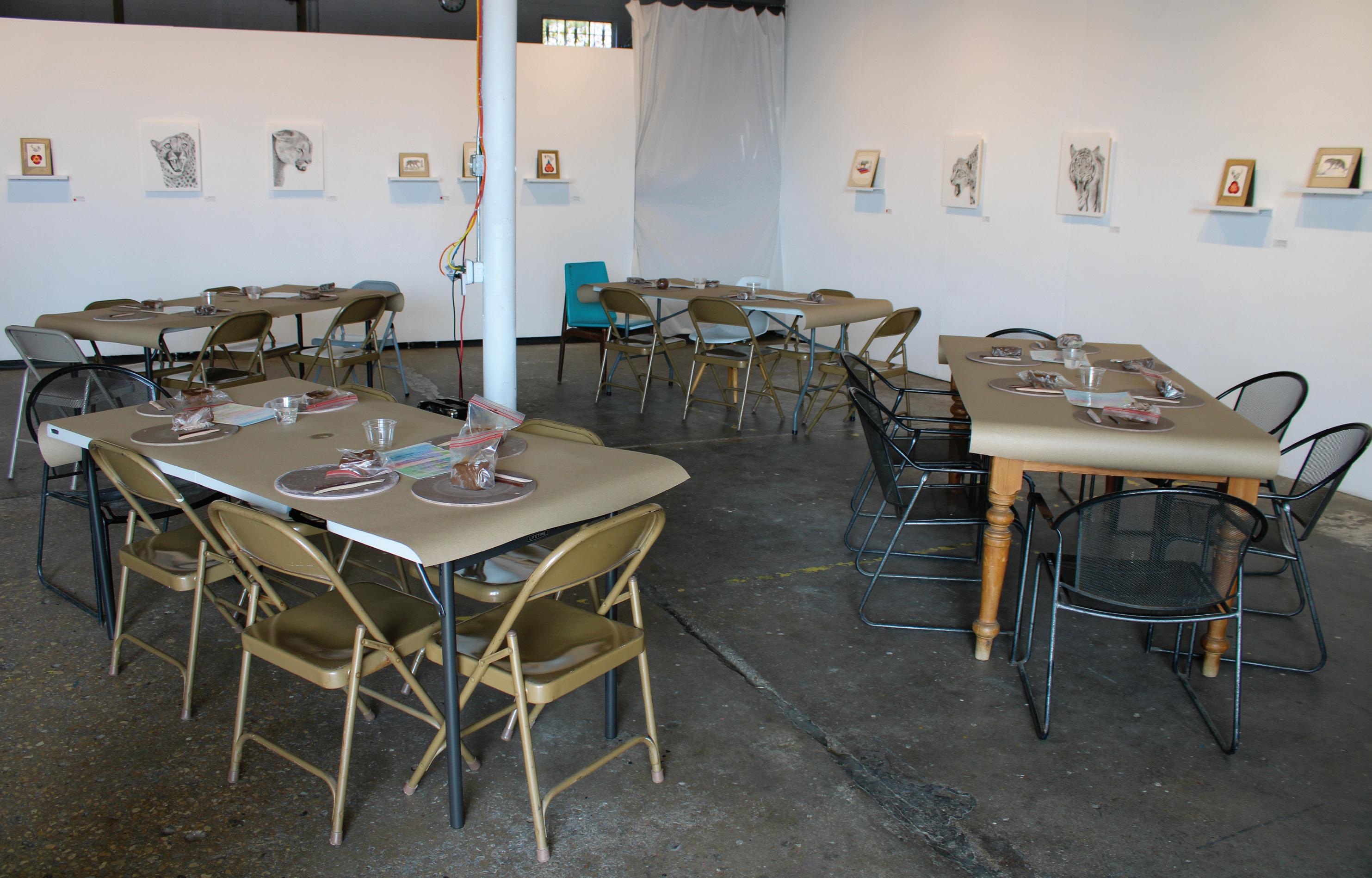
By Daria Tanase Staff Writer
Mercury Project is a contemporary art building in the Southtown Arts District of San Antonio founded by Antonia Richardson and Warren Borror in 2013. The two wanted a workplace that would foster creativity and growth for local artists. The Mercury Project works to support newcomers who are getting out into the art world.
When entering the Mercury Project, visitors are greeted with a warm and supportive environment and walls full of art. The people are what make the space so inviting, and whenever galleries and shows are hosted, you can sense a true collaborative spirit ring through the air. The artists and curators are always open to talking to guests, which makes for good conversation and helps to make things feel less intimidating. The art world can seem scary and vast, but Mercury Project works to create an atmosphere that is ideal for newcoming artists and curious locals.
“They wanted it to be a jumping-off point for beginner artists, who need support and a gallery to showcase their work,” says Rikkianne Van Kirk.
Van Kirk has worked with the Mercury Project since 2018; she plays a vital role as the studio and property manager. This art studio serves as a mixeduse space with an art gallery, art studio spaces, and residential buildings, which Rikkianne works to manage.
Since she has been living above the studio for a while, she has witnessed the tenants work together and collaborate over the years.
“I think it’s really neat,” Van Kirk said. “You walk down here [and] someone is painting. Someone is constructing a bed. You hear people talking about art shows.”
The studios serve as a creative outlet for the artists who rent them out, but they still maintain their professional aspects because these creators are paying to be there.
“It’s cool. It’s creative. It’s inspirational and supportive, but it’s also serious,” Van Kirk stated. “It’s a very professional area. They pay for this space, so they have to work. It’s respectful because you have fun and are creative, but you are working.”
The artists “bring this area to life” as they manage
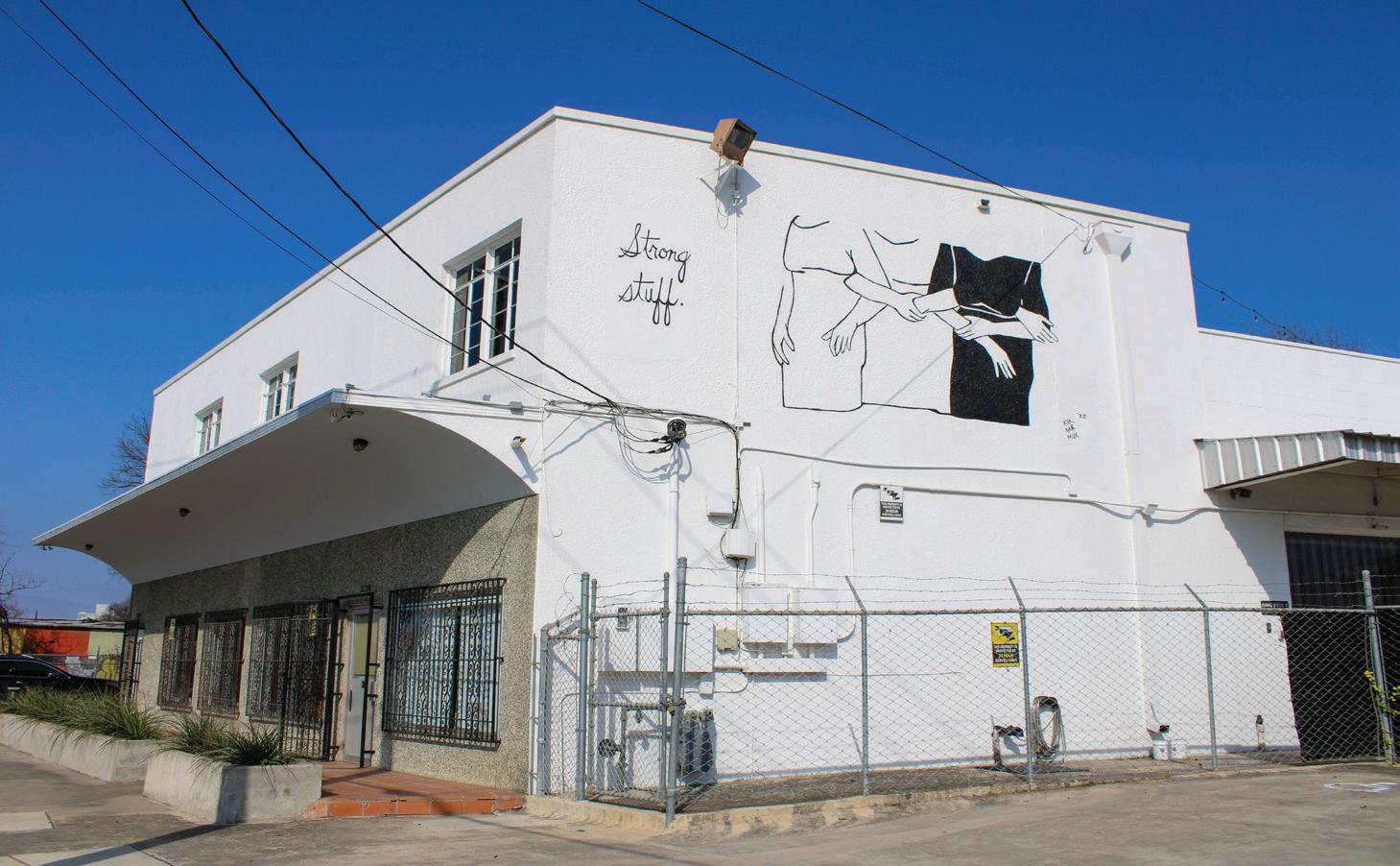
the galleries and host their shows. “They bring the building alive with exhibitions, photoshoots, yoga, community choir in the gallery [and] lots of interactive stuff,” Van Kirk explains. The artists who pay to work at Mercury are entitled to free gallery use each month and can do whatever they want with their time. “They can serve workshops, they can use the space to the best of their ability. It is run by them completely.” Mercury Project constantly has events and interactive events that the general public can attend. Checking out their Instagram will give you an idea of what shows pop up throughout the month, as their open gallery hours are dependent on when the artists are hosting shows. It serves as a great space for young artists to take inspiration from and see what the San Antonio art world is like. It is genuinely an inviting place if someone does not know how to get out there and connect with the community. There is such good conversation, connection and information that is shared underneath the roof of the Mercury Project.

By Sarah Quintanilla Assistant Graphics Editor Review
Heartbeats introduce the title track “Eusexua.” FKA twigs pairs breathy vocals with a light prickling beat and echo, haunting the listener every passing second. The listener might ask, “What does Eusexua even stand for?” FKA twigs would respond by releasing songs that one may lose themselves in, setting the tone with faint, alien-like sounds in a genre-defying record.
Y2K club bangers started to gain traction after Charli XCX’s “Brat” was released in 2024, making a smooth transition for this genre to evolve. FKA twigs’ next song, “Girl Feels Good,” plagues this genre with autotune. This album does not have songs to dance to. Its tracks are meant for sitting alone in a corner and brooding. Nonetheless, it is a relaxing tune, giving the listener hope that the following tracks might be catchier.
“Perfect Stranger” has FKA twigs’ whispering vocals. Meanwhile, the faint techno and EDM influences overpower the song. One cannot ignore that this is something to be played at a 5 a.m. yoga class.
The single, “Drums of Death,” has a clap and a muted beat with chopped intermissions, in which her vocals enter after a minute and a half. She sounds whimsical in an edgy, fairylike way — much like the industrial version of Kate Bush.
The most clear example of the Y2K influences is heard in “Room of Fools,” which is reminiscent of a less intense version of Trent Reznor and Atticus Ross’ “Challengers” soundtrack. This track is the highlight of the album. The Björk reference of “Venus as a Boy” shines towards the end as FKA twigs fades into the next track.
FKA twigs murmurs the lyrics in “Sticky” and “Keep it, Hold it.” Muted instruments and her breathy, soprano voice bring nostalgia that one would only feel in the dawn of the most hidden depth of the woods, and then there is a techno beat. Imagine Disney’s “Brave,”

but on hallucinogens — haunting in a Scottish folk tale sort-of-way.
North West features on “Childlike Things.”
FKA twigs and West bring the listener a Japanesepop-sounding track, with West praying in Japanese. It is ironically catchy, yet a fever dream of a song.
FKA twigs’ breaks free from the grasp of the last song to continue her EDM-techno-artsy musical exploration with “Striptease.”
She does not go faster than 120 bpm in the whole album, yet contemporary dancers can easily find a way to move to it; the same goes for “24hr Dog.” This one is a skip due to her slight mumbling combined with heavy autotune and a slow muted synth.
“Wanderlust” jumps from the previously used genres to a song in which FKA twigs’ soprano vocals are fully showcased. It is artsy. It is alternative, and it has a slight Massive Attack flair to it, ending the album in a way that leaves the listener in a trance.
“Eusexua” is the perfect record to explore the horizons of synth sounds and recurring shower thoughts. While it does not have any instant hits, the album’s overall feel would be exponentially aided by staying at home on a rainy day.
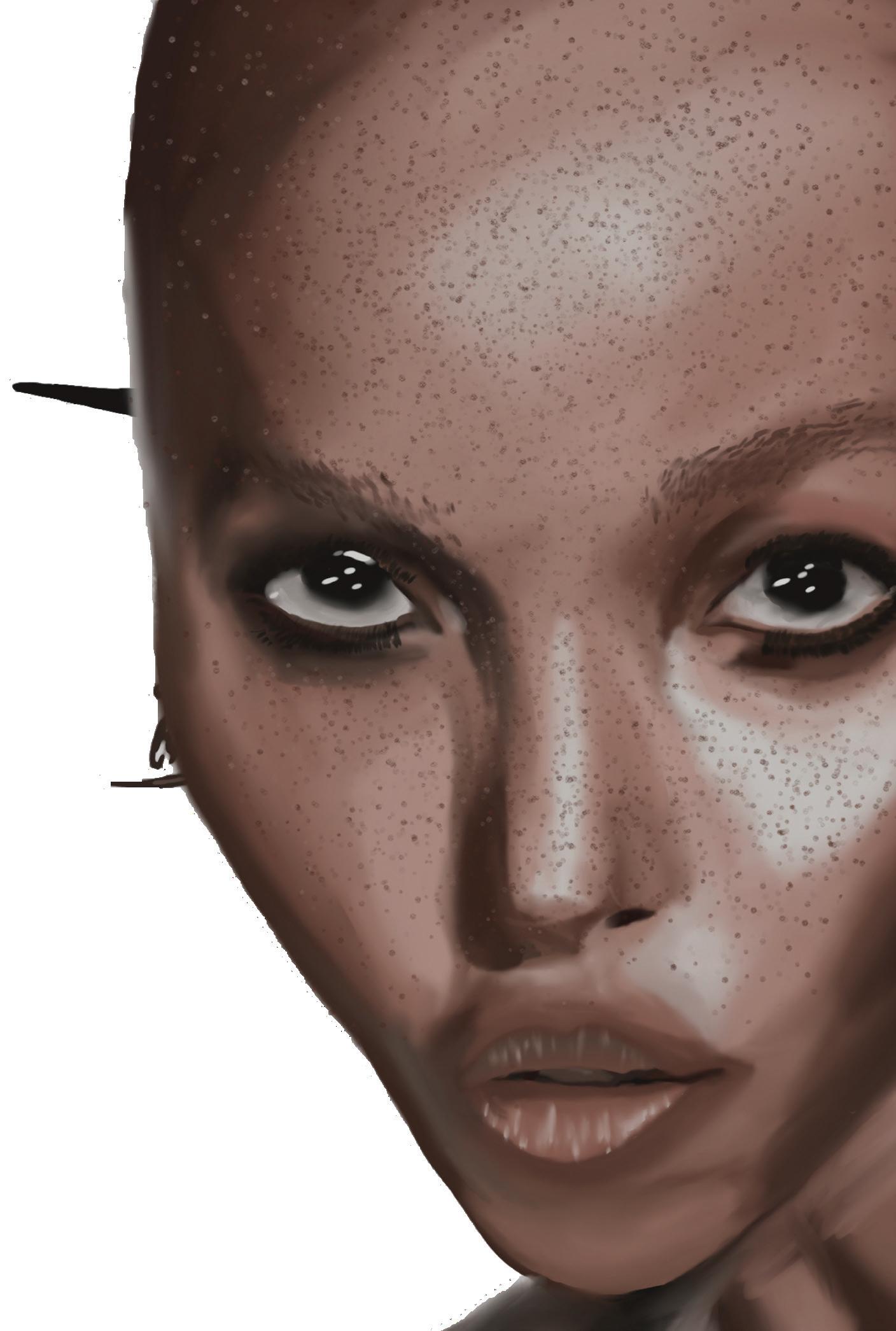
By Marisela Cruz Assistant News Editor
UTSA’s Institute of Texan Cultures introduced the Folklife Festival in 1972 to celebrate the many cultures found in Texas. The annual festival took place at the Texas Pavilion, a historical landmark spanning 10 acres. The event would last for over three to four days, with approximately 100,000 Texans coming to celebrate and share their culture as a collective. ITC has not hosted the Folklife festival for the past five years. When the festival was up and running it highlighted over 40 nationalities, including Belgians, Scotts, Mexicans and Romanians. Each group had a booth showcasing their hand made crafts and food, to San Antonio and Texas overall. Former director of the Folklife Festival, Jo Ann Andrea, participated as a Lebanese dancer when the event was first established in 1972. Andrea gave an extensive recapitulation of the
years she was part of the celebration of Texan cultures.
The Folklife Festival aimed to help all cultures be showcased to the citizens of San Antonio. Uniting a community of thousands of people was said to be a “problem solver” according to Andrea, and to “bring people together in celebration of a lot of the things that we all shared in common.” The diversification of participants of the festival included people from Europe, Asia, and Latin America. Some groups would present how they came to settle in San Antonio. The Canary Islanders in particular made a presentation of how they settled in San Antonio, displaying an ancestral relationship with the city and the generations of people who found solace here.
Everyone’s skills and contributions were showcased through pioneer crafts. Each year there would be artisans and craft makers, with basket makers, potters, rope makers, sheep shearing, goose plucking and even a masterclass on how to build a log cabin. Many stages spanned across the festival introducing musical

and dance performances. Some of the most popular performances according to Andrea were the “Lebanese folk dancers” and the “Hawaiian Aloha electric group.”
There was a sense of responsibility that the organizers of the festival felt that they had to do when showcasing the many cultures that occupy the Texas community. It was essential to “showcase them and introduce them to our community,” Andrea said. She continued, “This was a Texas Folklife Festival. Although it was located in San Antonio. People came from East Texas, West Texas, to be a part of this, and it was a celebration of Texas, not just San Antonio.”
After the outbreak of COVID-19 in 2019, the festival was discontinued. In the time since the festival’s hiatus, the ITC closed in May 2024.
“It was a defining moment not just for us, but for many festivals across the United States,” Andrea said. The legacy of the Folklife Festival will forever be embedded in the history of San Antonio.

By Christopher Delgado
Copyediting Coordinator
Within Chicana literature, Gloria Anzaldúa promoted the Nahuatl term “nepantla,” which means “in between.” Inspired by Anzaldúa, Lisa Alvarado explores the crossroads of her Mexican-American heritage and institutional fine art concepts in “Trace Memory,” which is on display at the Southwest Campus’ Russell Hills Rogers Gallery until Feb. 28.
The gallery displays textile work, mixed-media photography and a video recording of the Natural Information Society Community Ensemble’s “descension (Out of Our Constrictions).”
Alvarado utilizes zig-zag patterns, neon colors and heavy brushstrokes to breathe life into the textiles. Her pieces infuse the cultural history of textile making with fine art techniques; the artworks are seemingly moving. Human silhouettes form within the weighty brushstrokes as one examines “Traditional Object 13.” The negative space begins to take over the lumps of pink paint. “Traditional Object 13” is not stagnant. It is in conversation with the viewer.
“Traditional Object 6” and “Traditional Object 5” seem to be in a shootout, given their positionality to one another. The pieces face one another as they beg audiences for attention. The neon reds and greens allude to Alvarado’s Mexican-American heritage. Given the use of the colors of Mexico’s flag, the heritage cannot be contained, despite the several borders placed on the textile. The radiance of the pieces causes one to lose track of where the artworks end and where they begin.
Beginning in 2020, Alvarado created mixed-media photography to reinforce her Mexican-American heritage. Four pieces titled “Thalweg” reflect the impact of Mexican repatriation on Alvarado’s ancestors.
“Thalweg (Luna 1)” and “Thalweg (Luna 2)” focus
on a river and canoe of people. “Thalweg (Luna 1)” introduces a divide into the photographs as a faded yellow line divides the photo into two uneven sections. A line that some may feel symbolizes the controversial Mexico-U.S. border set by the signing of the Treaty of Guadalupe Hidalgo that resulted in Mexico losing 55% of its territory to the U.S. “Thalweg (Luna 3)” presents a portrait of Alvarado’s grandmother touting a cross pendant as she tearfully stares at a canoe of people. “Thalweg (Luna 4)” spotlights Alvarado’s great-uncle, who stares into the camera lens with a tightened jaw. Alvarado positions her great-uncle’s portrait alongside an empty river. The juxtaposition creates a seemingly lost sense of identity. Alvarado embosses the photos with curved patterns that grant the still portraits and landscapes a sense of movement. Alvarado’s ancestors are no longer stuck in time. They are not erased; they live on.
In a separate room, Ari Brown and the Natural Information Society Community Ensemble’s performance of “descension (Out of Our Constrictions)” at the 2022 Pitchfork Music Festival plays. Alvarado plays the harmonium while the song’s writer, Joshua Abrams, plucks the guimbri. The musical arrangement heightens the sensory experience of Alvarado’s textiles, with 40 minutes of the performance playing.
Multiple conversations occur at “Trace Memory.” Textiles and photos speak to audiences, while a separate discussion takes place between the visual artworks and the auditory art. Alvarado’s work begs audiences to engage with all their senses. Her work is not confined within its framed spaces; it exists in the “nepantla.”
Engage with Alvarado’s “Trace Memory” at the Russell Hill Rogers Gallery at 1201 Navarro St. The gallery is open Thursday to Saturday from 12 p.m. to 5 p.m. “Trace Memory” will be on display until Feb. 28.
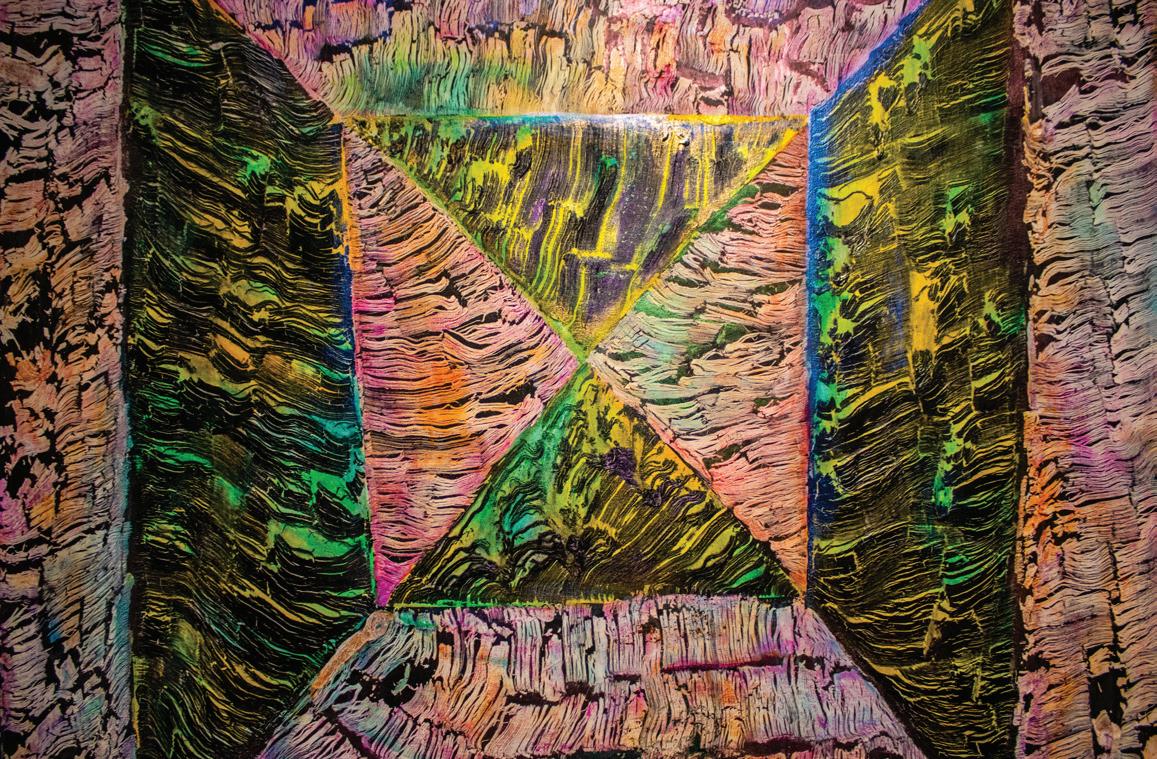

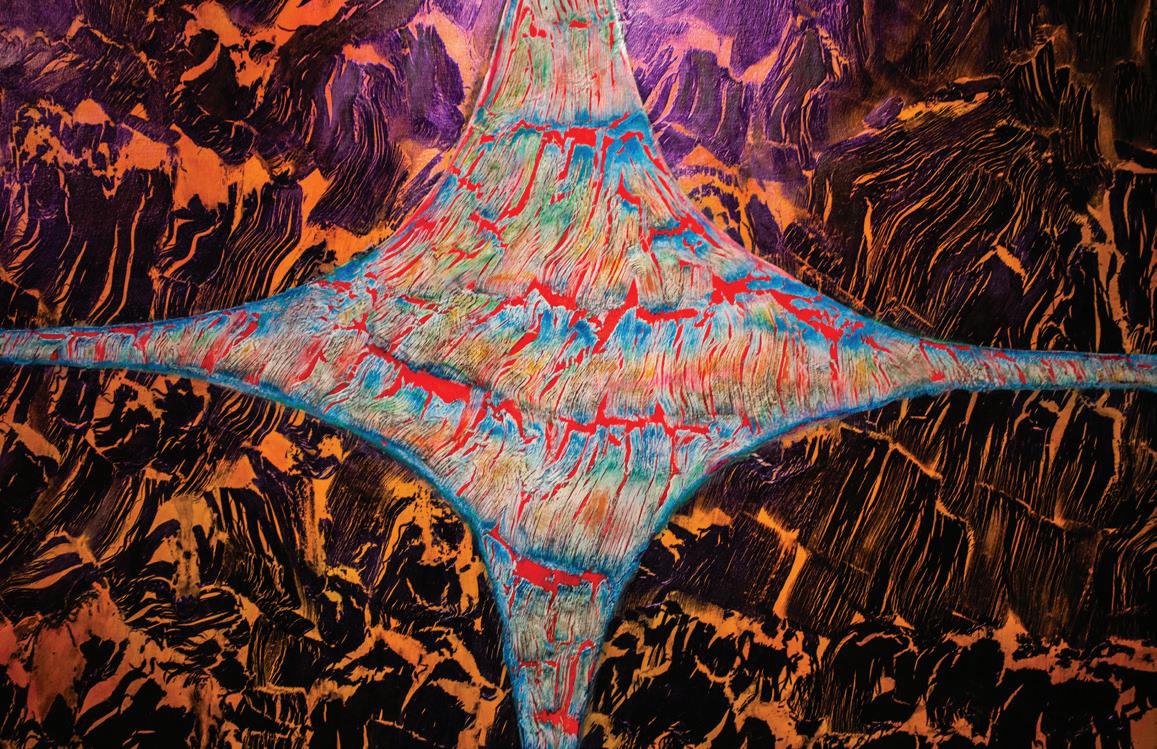
By Olivia Literas Contributor Review
A brand new slasher, rom-com flick comes just in time for Valentine’s Day, putting all types of movie lovers in the mood for a striking love-filled film.
“Heart Eyes” was released on Feb. 7, and is directed by Josh Ruben and produced by Spyglass Entertainment, the company behind the fan-favorite “Scream” franchise. Although many fanatics of both the romance and horror world were roused by the release of this film, “Heart Eyes” might just be the swipe left for Valentine’s disappointment of the year. Like any good romance movie, Ally, played by Olivia Holt, and Jay, played by Mason Goodling, share an undoubting chemistry the moment they appear on-screen in a clichéd same coffee-order scenario. Jay plays up the “hopeless romantic” archetype as he continuously tries to woo Ally, who absolutely does not want anything to do with him at first. Ally, plays up the “love is hopeless” trope as she is going through a breakup and is on the verge of getting fired from her job, and she thinks Jay is part of the blame. Meanwhile, the nationally recognized Valentine serial

killer, of the film’s namesake, “Heart Eyes” is on the rise again. This year he has set his sights on Seattle, always lurking and striking any pair of lovers he comes across — leaving a trace of fear in the back of the entire country’s minds. After an awkward misunderstanding shared by Jay and Ally, Heart Eyes is locked onto the two of them and will not rest until death do they part.
“Heart Eyes” delivers an immersive balance of sappy rom-com moments and fun inventive kills that leave the audience guiltily begging for more gorey heartbreak. In the opening scene, the Heart Eyes killer crashes a beautiful wedding proposal set in the bright Seattle countryside that is left dark and bloodied by the time his job is done. The powerful presence of this slasher is felt at the very beginning and drags through the movie as the audience realizes he will stop at nothing for his next kill. “Heart Eyes” does a great job of epitomizing lovey-dovey aesthetics and cheesy Valentine’s traditions with its warm-toned cinematography. Whenever Heart Eyes debuts, tar is dumped on these visuals, causing a thrilling, suspenseful atmosphere.
With all of the brilliant work put into this film, its messy plotline is the only vanquish that disregards all of the creative allusions and hunts. This film capitalizes on the raw tropes of both horror and romance. It does not create new types of tropes many may be expecting with this mix of genres. It seems like the film was trying to mix oil and water in this department. After so much build-up, the “grand reveal” anticipated in every slasher falls flat, and it throws away many great moments that could have been enhanced. Some scenes where characters try to reach and relate to different age groups’ experiences in the dating world make the film hard to watch and take away from the credibility of the two genres. Despite its flaws, “Heart Eyes” is still an entertaining movie and a fun date idea for this Valentine’s Day. With so many different features and tropes built up in its one-hour and 37-minute screen time, there are many things one would find charming about this film. For those interested in a casual Valentine ’s-themed outing, “Heart Eyes” is now playing in theaters.



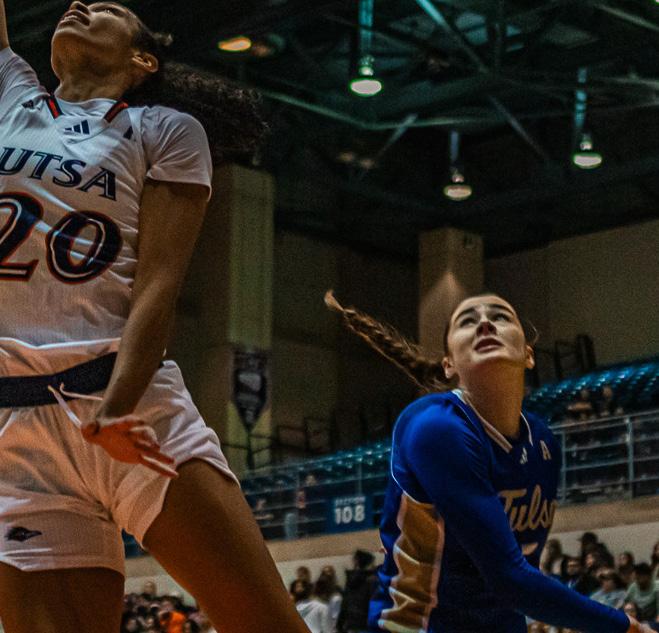
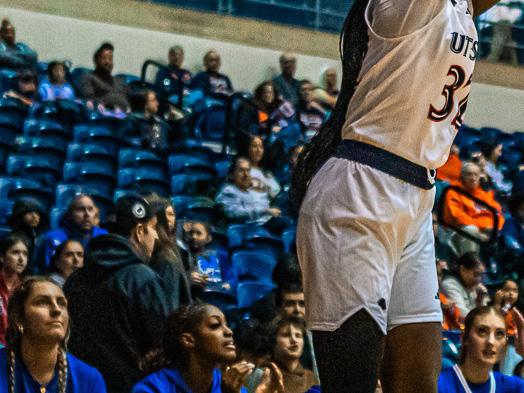
By Aramis Santiago
a staggering 20 wins and only three losses, UTSA women’s basketball possesses the top record in the American Athletic Conference and one of the best records in all of women’s college basketball. The Roadrunners hold a 10-1 record in the AAC and have suffocated teams with a formidable defense.

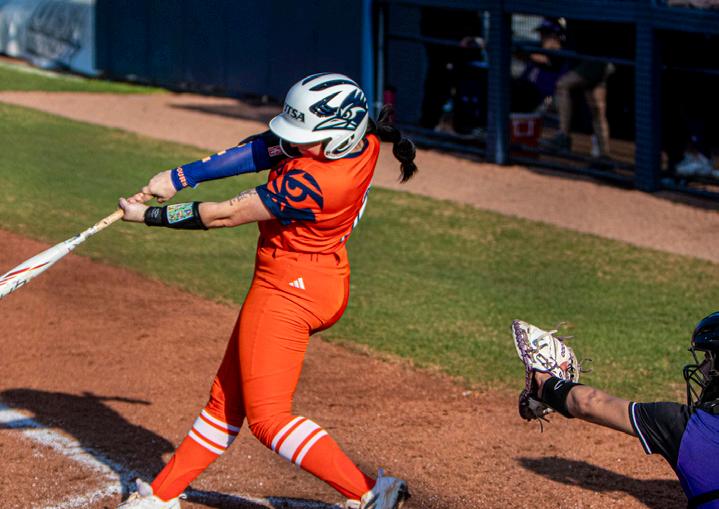
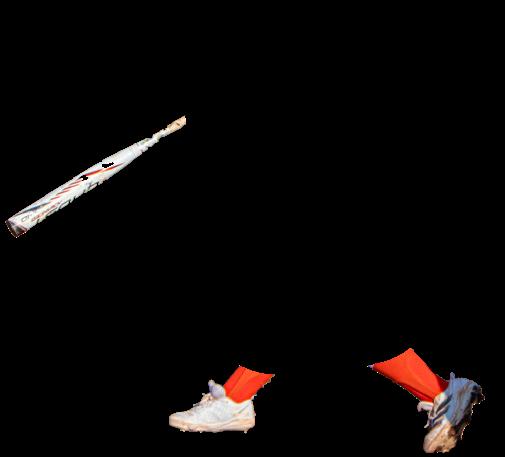


Despite this, UTSA has received very little respect from the Associated Press, being ranked all the way down at 71. Adding insult to injury, it trails four spots behind South Florida, a team the Roadrunners have a better record than and nearly defeated without their best player. This lack of recognition is both egregious and disrespectful, especially considering the high level of play UTSA has sustained throughout the season. reason the AP may rank the Roadrunners so low is the perceived weakness of their schedule. The AP did not classify any of UTSA’s 20 wins as Quad 1 or Quad 2 victories. In the eyes of voters, these wins hold minimal weight because it falls into Quad 4, implying that UTSA’s opponents have not been particularly strong. On the other hand, the Roadrunners’ three losses, including competitive matchups against Texas A&M and Stanford, are
viewed as Quad 1 and Quad 2 defeats, which may further explain the ranking disparity.

This heavy reliance on quadrant classifications fails to capture how consistently UTSA has handled business against every opponent they’ve faced. The AP seems to ignore the fact that the Roadrunners have rarely faltered, which should account for more than these arbitrary metrics suggest. It’s difficult to justify this level of dismissal when evaluating how well-rounded and cohesive this UTSA team has become under coach Karen Aston. In just a few seasons, Aston has built a winning culture rooted in defensive intensity. The Roadrunners consistently hold teams to low shooting percentages and control the tempo of games with disciplined rotations and ball pressure. Aston’s system demands accountability and effort from every player, and the results are undeniable. UTSA has weathered adversity throughout the season, including gritty wins against strong teams like Rice, Tulsa and North Texas, illustrating their resolve and ability to execute in critical moments.
The Roadrunners’ depth and balance has driven much of their success. Senior forward Jordyn Jenkins has been the centerpiece of the team, but what sets UTSA apart is how contributions have come from across the roster. For example, graduate guard Nina De Leon
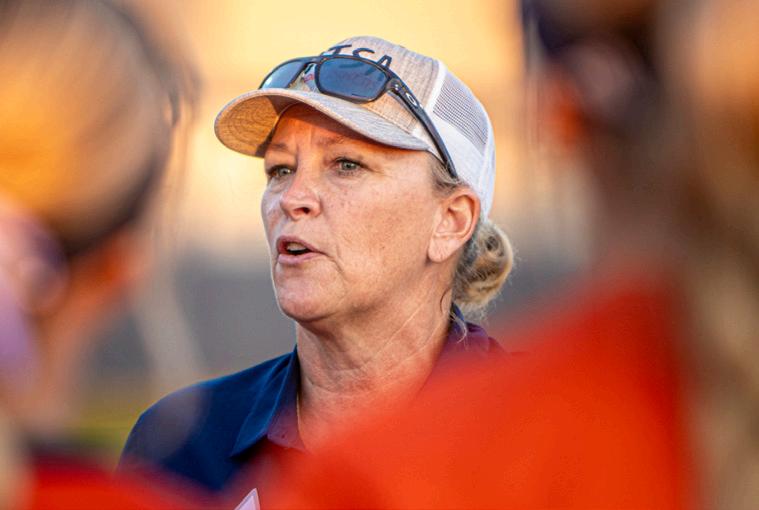

Negron has been a steadying force at point guard, managing games with poise and facilitating the offense efficiently. Players like junior guard Sidney Love and sophomore forward Idara Udo provide crucial support. With Love’s aggression in attacking the basket and Udo’s physicality in the paint bolstering both ends of the floor.
The fact that UTSA remains overlooked despite a 20-3 record points to a larger issue in how rankings reward reputation over results. Programs with historically successful pedigrees are often given the benefit of the doubt, while teams like the Roadrunners, who are steadily building something special, are dismissed based on perceived strength of schedule. However, success should not be measured solely by who a team has played but by how well they have performed. UTSA has proven time and again that they belong in the national conversation.
While the Roadrunners may not crack the top 25 immediately, the notion that the AP should rank UTSA outside of the top 70 is indefensible. This program is on a trajectory for an AAC championship and a potential NCAA Tournament bid. If the AP truly values competitive excellence, it will eventually recognize what UTSA has accomplished. Until then, the Roadrunners will continue to let their play speak louder than the rankings.

By Bailey Hall Staff Writer
UTSA softball opened its official season over the weekend, going 5-0 in the UTSA Invitational at Roadrunner Field. This season is one to look forward to as the players and coaches have worked hard on their mentality with the hopes of producing a better outcome.
“I hope the vibe is Vanntastic. It’s got a lot of energy, exciting, relentless,” coach Vann Stuedeman said. “Our core values are relentless, competitive, united and passionate, so I hope that’s the vibe people can feel when they get out here and see us play.
“We spend a good time working on [mentality], and it continues. You can see that they are invested in one another, and they actually want the best for each other and ultimately the best for the team,” she added. When Stuedeman took over as coach for the softball program ahead of the 2024 season, she focused on elevating the bond between her players. Her biggest goal for the players was to improve their mentality.
“It’s intentionality that we really worked on last year, to be intentional in our reps and to bring that mindset everyday and be consistent with it,” Stuedeman said.
Although the ‘Runners had a losing record last season, Stuedeman is optimistic about this season. She hopes to build off momentum garnered from last season and lead the team to a higher overall ranking in the American Athletic Conference.
Her work on the players’ mindset extends beyond the field and into their lives. Along with this, Stuedeman focuses on how the
players can overcome problems that arise on and off the field.
“We work a lot on how you respond to setbacks or a tough part in your life, how we can support each other and be there for each other through it,” Stuedeman said. “There’s always going to be that. They’re going to prepare us and help us get through it as long as we look at it that way. If we look at it like it’s holding us back, then it will hold us back. So it’s all a mindset. We really work on the right mindset to handle the things that get thrown our way.”
Stuedeman uses the Roadrunner as a reference for the players and draws connections between them, referencing the fight and grittiness the Roadrunner displays and for the players to take that into their lives.
“Physically you’re gonna make an error. You’re gonna throw the ball away. You’re gonna swing at a ball and miss it. You’re gonna walk a hitter. You’re gonna do something physical,” she explained. “But mentally, can you fight through that, or can you respond to that and do that consistently?
“There are always hurdles to jump over and curveballs to hit. That’s part of the training, the mentality of being able to bounce back from those.”
Stuedeman’s work on the players’ mindset has shone through on the field over the weekend when the ‘Runners were behind in four of five games, but stormed back to win the games. The Roadrunners won the UTSA Invitational championship game, holding Weber State University scoreless in the process.
“They work hard and invest in each other, and I think the investment in each other is what is so fun to see,” Stuedeman said.
By Rylan Renteria Staff Writer
UTSA baseball has flamed out of postseason play in the past two years. After coming out of the 2023 offseason relatively unscathed, the Roadrunners’ roster was finally hit by the transfer portal in 2024. Replacing talent is never easy, especially when the program loses five All-Conference players.
With his work cut out for him, coach Pat Hallmark and his staff got to work plugging the holes on the roster. Here are three new additions that could have the biggest impact for the Roadrunners in 2025.
In recent years, the team has struggled with its infield defense. Now with gaps inside those vital infield positions, the chosen starter for the positions is more crucial than ever. When Hallmark was asked who would fill the gap at shortstop that former Roadrunner Matt King left, he gave the nod to Hodge.
“At this point, I can say it would be Ty Hodge’s job to lose,” Hallmark said. “Very, very talented player. The talent is there for him to be a terrific baseball player, and we’re very excited to have him.”
Hodge came over from Houston Christian University where he started 50 games while collecting 46 hits, four home runs and slashing .249 at the plate. Hodge’s collegiate career began in 2022 at Texas A&M University where he saw limited action as a freshman. He’s a right-handed hitter that possesses good speed, posting a 6.52 60-yard dash with a 1.67 10-yard split. Hallmark did note that Hodge has a bit of an injury issue. If he’s able to stay on the diamond, expect for
him to be a key cog in the Roadrunner offense.
Jordan Ballin, infielder
Ballin can play shortstop and second base according to Hallmark, and is in contention for the starting spot at both.
“If Ty is not able to go with the injuries, it’ll be Jordan Ballin, local freshman from Boerne. Terrific player, so those will probably be the leading two candidates,” Hallmark said.
“Jordan is battling Diego [Diaz] tooth-and-nail,” he added when asked about second base.
Ballin flashed in the team’s Fall World Series, showcasing his quick speed and his ability to reach base. Ballin joins the Roadrunners as the No. 67 ranked shortstop in the state according to Perfect Game. He projects to be a fan-favorite with a last name like “Ballin” – though Hallmark notes is actually pronounced “bah-YEEN.”
Kendall Dove, pitcher
Dove, along with fellow newcomer Sam Simmons, were names coined by returning players James Taussig and Zach Royse as players on the revamped pitching rotation that have stood out throughout the offseason. Dove boasts an array of different pitches, all with impressive speeds. The most notable of the bunch is his 88 mile-per-hour fastball. Hailing from New Caney, Texas, Dove played his freshman season at Texas A&M-Corpus Christi where he notched 24 strikeouts in 35.2 innings. With Hallmark looking to fill his “stopper” role that Ruger Riojas filled in 2024, don’t be surprised if Dove acquires the mantle.
UTSA baseball will begin its 2025 campaign this weekend, Feb. 1416, against the University of Texas at Arlington — a rematch of the Roadrunners’ opening series in 2024.
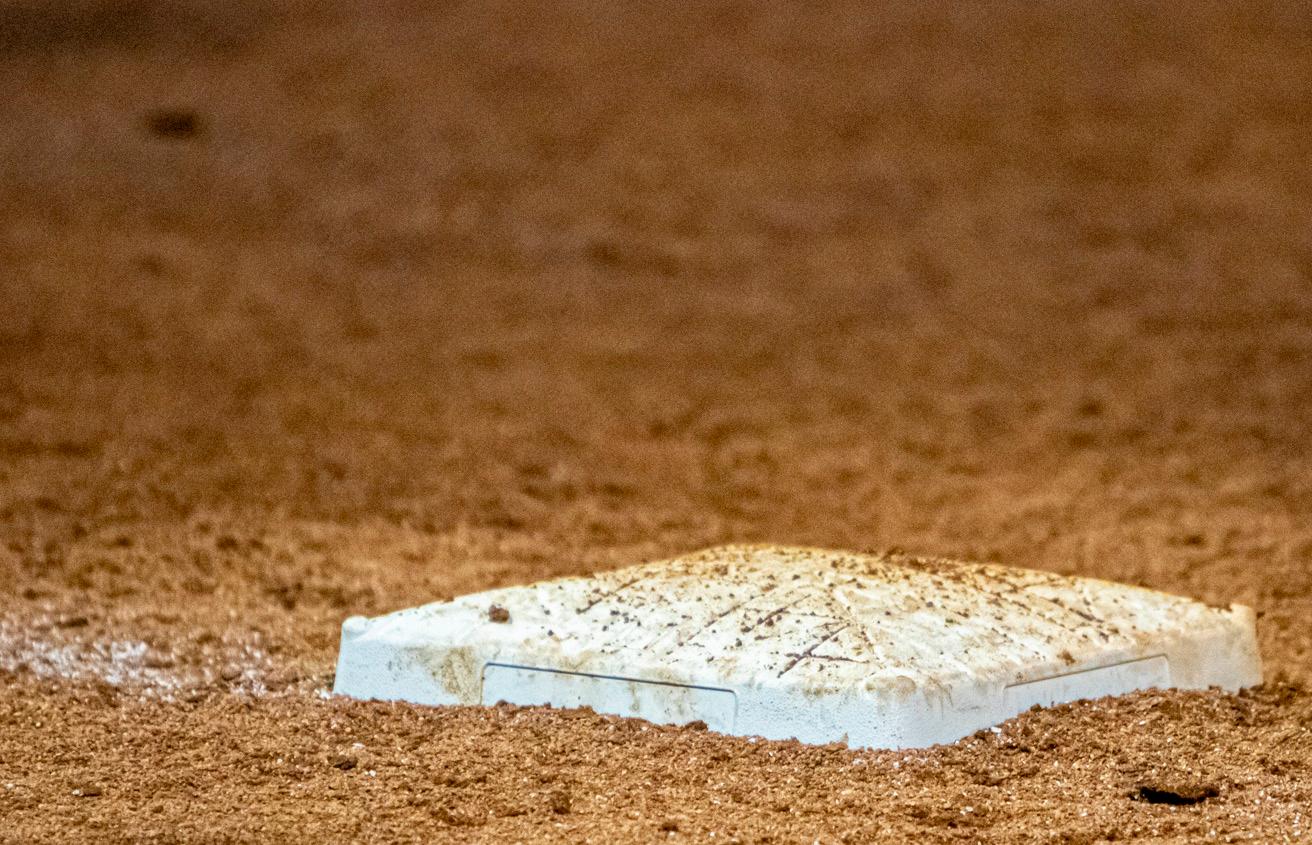
softball Begins spring season with a 5-0 record, read recaps online
By Haley Aguayo Sports Editor
By Bailey Hall Staff Writer
Read at paisano-online.com


By Alejandra Garza Staff Writer
The UTSA women’s golf team opened its spring season by competing in the Puerto Rico Classic hosted by Purdue University. The starting lineup for UTSA consisted of Daniela Abonce, Maria Bastarrica, Morgan Ellison, Lauren Rios and Olivia Williams. The Roadrunners competed against 18 teams over three days.
Grand Reserve Puerto Rico is an experienced golf course with views incomparable to other courses. The course sits alongside the beach where palms can be found throughout the course. Despite the beauty, the weather impacted the team’s approach as Puerto Rico’s climate is ever-changing.
“With the wind and how windy it was, we faced a lot of side wind, so I think just being confident in the club you picked, the number [of] your line and making sure you take a free swing,” Ellison said of combatting the weather. She continued, “I know for me off the tee I did not have to adjust for the wind side to side as much, just because my ball stays pretty straight when I hit it good.”
“I agree with what Mo said. The coaches emphasized that we all think we did pretty good on body language and attitude,” Abonce added. “We were mentally strong. That is why we improved each day and ended up on a high note climbing up the leaderboard.”
The resort is home to PGA tour events such as the Puerto Rico Open, which will take place at the beginning of March. The course’s conditions were different for the team — in particular, the type of greens each hole had — but the team was able to persevere.
“The greens were not the best that we have seen. They were a little bit slow and a little bit bumpy,” Ellison said. “The PGA tour is playing there at the beginning of March, so I think they don’t wanna cut them too low yet.
Although the greens and grass were different for Ellison in her short game, Abonce was more familiar with the course’s conditions as it reminded her of her hometown — Veracruz, Mexico.
“It was very similar to what we have, the type of grass and the type of layout that we have in Veracruz,” Abonce said. “You don’t really see that type of grass, which we call it in Veracruz kikuyu; it is a very tropical type of grass.”
“For most of the pins, you could be pretty aggressive at [them]. There was
By Christian Loustaunau Distribution Manager
Ford, the American automotive giant with a rich history in motorsport, has announced its return to the FIA World Endurance Championship in 2027 to compete in the prestigious Hypercar category. This marks the brand’s longawaited comeback to Le Mans after nearly six decades.
The highly anticipated season will pit Ford against a formidable grid including manufacturers such as Alpine, Aston Martin, BMW, Cadillac, Ferrari, Genesis, Peugeot, Porsche and Toyota, a promising new golden age for WEC.
“I am thrilled that we’re going back to Le Mans and competing at the highest level of endurance racing,” Bill Ford, executive chair of Ford Motor Company said. “We

a couple that were kinda on or near slopes,” Ellison added. “For the most part, we were able to be pretty aggressive at them.”
Coach Summer Batiste and coach Taryn Torgerson emphasized playing with confidence. Confidence was key again for UTSA as the classic progressed, with each player producing a better score.
Rios led the team on day two with a score of 73, trimming six strokes off her day one score. Williams lowered her score each day (77-75-74); Bastarrica managed to improve on day three of the tournament, fine-tuning her game to shoot (75-77-74).
“I think we always try to be pretty confident. I wouldn’t say out there in Puerto Rico that there is a lot of shots that are like super scary with a lot of water or anything,” Ellison said. “I think we have all the shots that it takes to score on that golf course.”
Abonce struggled a bit on the tournament’s first day, carding an 81, but she quickly recovered the next two days, shaving off her score by seven strokes both days.
“Well, my first round I think I got the most trouble off the tee,” Abonce said.
“I was just getting in positions, like I would be in the bunkers having to layup. Physically I could not go for the green or aim it somewhere else I think that got me in a lot of trouble.
“I had a couple of three putts; my up and down was not there,” Abonce added about her first round. “For the second and third day, I think I aimed more [at] how I could mentally improve, just to focus in fundamentals, mechanics [and] keeping my head centered.”
Ellison led the team in scoring, attaining a low score of 72 on the team’s final day. In reach of even par on day three, she recovered on 17 and one, recording a bogey, but counteracting with a birdie on 18 and two.
“I feel like this semester and year in general I have been very good on my mental game, just very steady [and] trying to enjoy my last year,” Ellison said. “I just kind of knew that there was lot of opportunities out on that golf course like 18 and two were both par-5, so I knew that I had opportunities to get there in two or hit it close for birdie.”
UTSA secured 15th place in the tournament, tying with the University of Minnesota. UTSA will compete in the Chevron Collegiate at the Golf Club of Houston on Feb. 24-25.
are ready to once again challenge the world and go like hell.”
Ford’s return to Le Mans in 2027, after nearly 60 years, reignites the legendary rivalry between Ford and Ferrari, adding a new layer of competition to Ferrari’s current dominance in the Hypercar category. This move serves as a powerful reminder of Ford’s historic achievements in endurance racing, challenging Ferrari and other manufacturers to recognize the American brand’s ability to disrupt the established order once again.
The revival of this iconic battle echoes the fierce competition that began in the 1960s when Ford first sought to dethrone Ferrari’s reign at Le Mans, reminding Ferrari of the deep-rooted rivalry that once redefined motorsport.

By Aramis Santiago Staff Writer
After an eventful trade season which saw one of the most shocking trades in NBA history unfold, fans and analysts were abuzz. Yet amidst all the headlines, the spotlight soon shifted to another major move many had anticipated: the Sacramento Kings trading De’Aaron Fox to the San Antonio Spurs.
While this trade did not cause the same immediate media frenzy as the Dallas Mavericks trading Luka Doncic to the Los Angeles Lakers, its long-term implications for the Spurs franchise and their generational star, Victor Wembanyama, are immense. The acquisition of Fox, a top-tier point guard in his prime, signals a seismic shift in San Antonio’s ambitions as they position themselves for the future.
Fox’s move to San Antonio was no coincidence. Just a week before the trade deadline, he formally requested to be traded, making it clear that the Spurs were his preferred and only destination. His desire to join San Antonio reflected what many players around the league have already recognized: Wembanyama’s talent is undeniable.
At 7-foot-3 with a rare combination of skills, Wembanyama is viewed as the NBA’s next transcendent player. Fox’s arrival provides him with an ideal backcourt partner. Known as one of the fastest guards in the league, Fox will elevate Wembanyama’s game through his playmaking and ability to break down defenses. Together, they form a duo capable of dominating in transition and half-court sets.
One of the biggest on-court impacts is the Spurs’ improved ability to close games. Early in the season, San Antonio struggled with consistency, often losing games due to a lack of veteran leadership in crucial moments. Fox changes that entirely. His ability to create his own shot and run the pick-and-roll with Wembanyama will make the Spurs far more effective in crunch time, forcing defenses to pick their poison. Fox’s speed and court vision will free up Wembanyama to operate both inside and outside the paint. Their pick-and-roll will create constant mismatches
for opposing defenses. With Fox running the offense, Wembanyama will have more opportunities to impose his will on both ends of the floor, making the Spurs even more dangerous.
Fox’s leadership and experience will also be invaluable for this young Spurs team. He helped lead the Kings to their first playoff appearance in nearly two decades and understands the demands of postseason basketball. His presence will provide guidance for Wembanyama, Devin Vassell and others as they develop the consistency needed to compete at a high level. Beyond the immediate oncourt impact, this trade is a statement to the league: San Antonio is back on the map as a destination franchise.
The Spurs completed this trade without giving up key young players like Jeremy Sochan, Vassell or Stephon Castle, nor did they part with any of the Hawks’ valuable first-round picks, maintaining a strong core and future flexibility. While they sent out multiple draft picks, the Spurs retained enough assets to continue building through the draft or pursue future trades. Fox’s arrival is also expected to accelerate the development of these young players and attract future free agents eager to play alongside Wembanyama.
Ultimately, this trade marks a turning point for the Spurs. With Wembanyama and Fox leading the way, San Antonio has gone from a promising rebuild to being just a move or two away from serious contention. As the two build their chemistry, the Spurs are on the verge of establishing a dominant new chapter in the franchise’s storied history. With a deep core of young talent and valuable assets, the Spurs are




